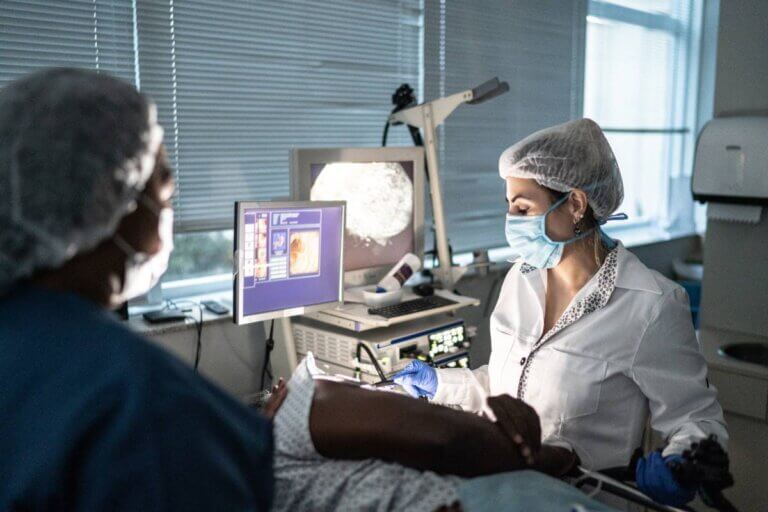
Endoscopy is a common medical procedure used to diagnose and treat conditions within the digestive tract. It involves the insertion of a flexible tube equipped with a camera, an endoscope, through the mouth or rectum to visualize the esophagus, stomach, intestines, or colon. While endoscopy is safe and minimally invasive, some patients may experience discomfort or mild side effects after the procedure. Understanding these post-endoscopy symptoms and knowing how to manage them can help patients recover more comfortably.
For patients who undergo an upper endoscopy, a sore throat is common. The endoscope can cause irritation to the throat and esophagus, leading to soreness or a scratchy feeling 1,2. Additionally, during the procedure, air is often introduced into the digestive tract to expand the area for better visualization. This can result in feelings of bloating, gas, and abdominal discomfort 1,2. Patients who undergo a colonoscopy may experience cramping or abdominal pain due to the stretching of the colon by the endoscope and the air introduced during the procedure 3. Nausea can also occur due to the sedation used during the procedure or as a reaction to the air introduced into the digestive tract; this is generally short-lived and managed with proper hydration and rest. Relatedly, the sedatives used during endoscopy can cause drowsiness and fatigue for several hours post-procedure 4,5.
Resting and avoiding strenuous activities for the remainder of the day following the procedure is crucial for recovery 6. Patients should stay hydrated by drinking plenty of fluids, which can help alleviate nausea and flush out any remaining sedatives from the body 1. For those experiencing a sore throat after an upper endoscopy, using throat lozenges, drinking warm tea, gargling with salt water, or taking over-the-counter medications can provide relief 7. Eating light meals post-procedure can help avoid further irritation to the digestive system. Once a patient can swallow without pain—usually shortly after the procedure—they can return to their regular dietary regime 6,8.
While mild discomfort is usual after an endoscopy, certain symptoms may indicate complications and require prompt medical attention. Patients should contact their healthcare provider if they experience severe or persistent abdominal pain, high fever or chills, vomiting blood or passing black, tarry stools, any difficulty swallowing that worsens over time, and/or chest pain 8.
Endoscopy is a valuable diagnostic and therapeutic tool, but patients may experience discomfort after the procedure. By understanding the common post-procedure symptoms and following simple management strategies, patients can ensure a smoother recovery. While most discomfort is mild and resolves quickly, it is important to be aware of warning signs that necessitate medical attention. Staying informed and proactive can help patients navigate the post-endoscopy period with greater ease and confidence.
References
1. Upper GI Endoscopy After Care: Common Symptoms You Shouldn’t Ignore – Wilson N. Jones Regional Medical Center. Available at: https://wnj.org/upper-gi-endoscopy-after-care-common-symptoms-you-shouldnt-ignore/. (Accessed: 20th June 2024)
2. Upper endoscopy – How you prepare – Mayo Clinic. Available at: https://www.mayoclinic.org/tests-procedures/endoscopy/about/how-you-prepare/ppc-20395194. (Accessed: 9th April 2024)
3. Upper endoscopy – Mayo Clinic. Available at: https://www.mayoclinic.org/tests-procedures/endoscopy/about/pac-20395197. (Accessed: 2nd October 2023)
4. Amornyotin, S. Sedation-related complications in gastrointestinal endoscopy. World J. Gastrointest. Endosc. (2013). doi:10.4253/wjge.v5.i11.527
5. Upper Endoscopy – Nausea, Ulcers & H. Pylori Breath Test – Orange County – Irvine, CA & Huntington Beach, CA: Digestive Disease Consultants of Orange County. Available at: https://www.ddcoc.com/contents/procedures/upper-endoscopy. (Accessed: 20th June 2024)
6. Chest pain after endoscopy: Causes and how long it lasts. Available at: https://www.medicalnewstoday.com/articles/after-endoscopy-chest-pain. (Accessed: 20th June 2024)
7. Upper GI Endoscopy: What to Expect at Home. Available at: https://myhealth.alberta.ca/Health/aftercareinformation/pages/conditions.aspx?hwid=uf9380. (Accessed: 20th June 2024)
8. Patient education: Upper endoscopy (Beyond the Basics) – UpToDate. Available at: https://www.uptodate.com/contents/upper-endoscopy-beyond-the-basics/print. (Accessed: 20th June 2024)



